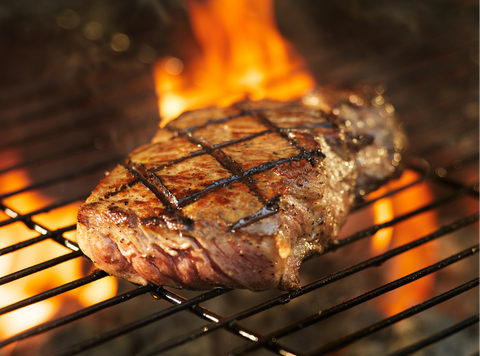Nothing is more satisfying than putting some time into a good steak and it comes out better than you expected.

This is a loose guide. There are so many different cuts of steaks and methods to achieve steak awesomeness but when I say steak, I mean beef steak from a cow.
Steak can be a very controversial topic. Not everyone likes steak. Those that do can argue, with passion, what constitutes a great steak. Different people have different rules about steak and how you should enjoy it. Ranging from well done with lots of ketchup to blue rare.
So, the art of cooking a good steak is subjective. If you are making a steak for yourself, you should make it the way you want it. We are going to go through all the different ways to get you to the steak you want and deserve.
Let’s explore the world of steak!
The Art of Cooking A Good Steak
Part 1: The Basics
This post is going to go over the basics for cooking a good steak. In the future, we will talk about different cuts and cooking techniques, but with these basics you are on the right path.
The four basic steps are:
- Selecting A Good Steak
- Season The Steak
- Cook Steak To The Right Temperature
- Let Your Meat Rest
If you put care into these steps, the results will be noticeable.
Step 1: Select A Good Steak
The first step is to try to get the best quality steak you can. If you can go directly to the butcher, the bests ones can tell you what to look for. If it is local, that is even better. In Nova Scotia, we are lucky to have a lot of farmer's markets, where you can buy meat directly from the farmer.
In a pinch, you can make almost any steak taste good. Local is going to just taste even better.
Look up independent butchers and farmers in your area. Here are a couple of great places to buy steaks in Nova Scotia:
Masstown Butcher Shop just outside Truro - They have a great selection (and a good supply of Big Cove Foods)
Vacheresse Meats in Antigonish - They have been in the business of good meat for decades and can cut any steak to any size when you order
Vessel Meats in Dartmouth - I haven’t been here yet, but I keep hearing great things about this shop.
There are different thing to look for various cuts, but marbling usually means delicious. Marbling is the white lines and flecks of fat in the steak.
You should also consider the thickness of the steak. Make sure you get one that suits your needs. If I’m cooking the steak at a high temp, I like to make sure the steak is at least an inch thick so I can get the right timing for a medium rare steak.
In future posts, I will get into various cuts and cooking techniques.

Step 2: Season The Steak
Salt is a mystical magical thing. And it's an important part of making a good steak. You can season your steak 24 hours before or right before you cook it. It's going to make it taste better than unseasoned.
Some people just like to add pepper when they salt. I usually like to add one of our spices. My go-tos are Espresso Nice and Worcestershire, Porcini BBQ Genie and soy sauce, or Mary Had A Lot Of Lamb with some olive oil and balsamic.
Step 3: Cook Steak To The Right Temperature (for you)
You want to cook it to the right temperature. Don't be a hero, use a meat thermometer. You don't want to over cook the steak. You can always cook it more if you have to. You can't uncook a steak.
My favourite instant read thermometer is the Thermoworks Thermapen One. It looks sexy and gives you an accurate temperature reading in one second. Easy to read and easy to use. Things you buy through this link may earn us a commission, but honestly, I have 3 of these at home.
Any good quality thermometer is an easy way to step up your cooking.
The following chart gives you the temperature you want to reach to remove the steak from heat.
| How Do You Like It | Remove Steak From Heat At |
| Rare | 115 F |
| Medium Rare | 120-125 F |
| Medium | 135 F |
| Well Done | 155 F |
| LinkedIn Bros Only | 165+ F |
Step 4: Let Your Meat Rest
You usually only have to let your steak rest for 5 to 10 minutes before you cut into it. Why do you need to rest your meat before you cut into it?
The short answer is it lets the juices mellow back into the meat instead of pouring out all over your cutting board allowing your steak to be more righteous.
If you want to read more about the science behind it, here is some further reading.

Stay tuned for a deeper dive into different cuts of steak paired with techniques to produce beautiful results.
I also read somewhere that they will soon be able to grow meat in a lab. And since it is grown, they can grow it to be any animal. So in the future you could be cooking a cruelty free tiger steak. Or even extinct animals. I don't know anything about how it works. I digress.
Love, Dave










